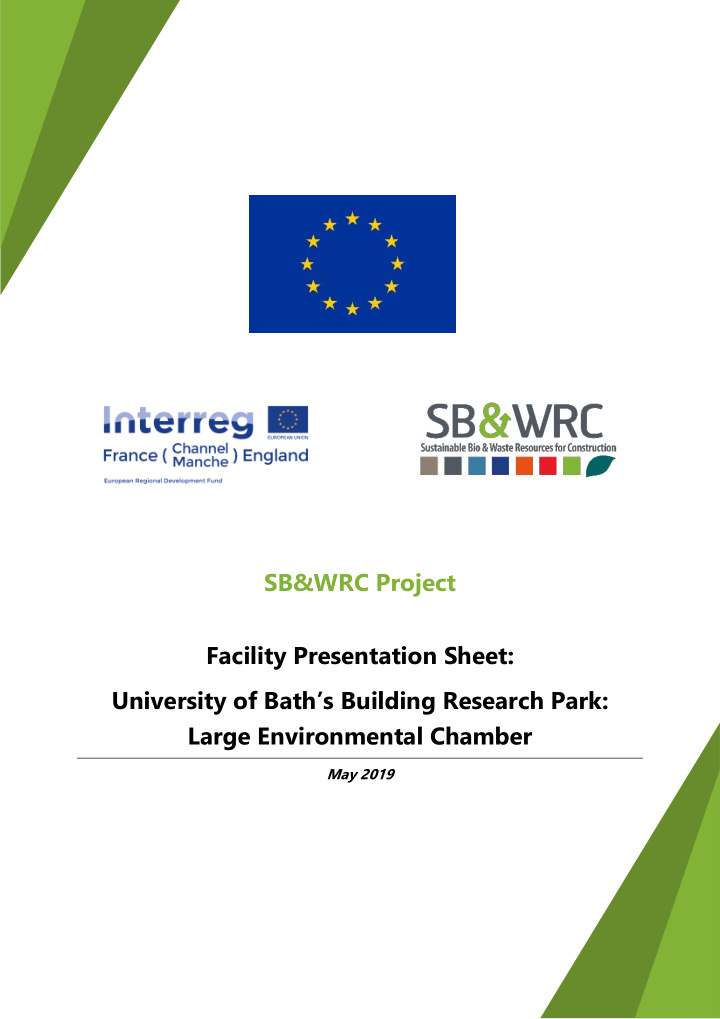



SB&WRC Project Facility Presentation Sheet: University of Bath’s Building Research Park : Large Environmental Chamber May 2019
Abstract of the project The SB&WRC (Sustainable Bio&Waste Resources for Construction) project, an undertaking of more than two years, aims to conceive, produce and test three innovative, low-carbon, thermal insulation materials from agricultural co-products and recycled waste. The project is supported by the development program Interreg VA France (Channel) England and its budget, estimated to be 1.8M€ , is co-financed by the ERDF (European Regional Development Fund) for 69% ( 1.26M€ contribution ). This project, led by Nomadéis, is carried out by a cross-channel partnership which gathers academic research laboratories, private research and consulting companies, manufacturers and professional non-profit organisation of the building sector: Nomadéis; − Veolia Propreté Nord Normandie; − − University of Bath; Ecole Supérieure d’Ingénieurs des Travaux de la Construction de Caen (ESITC Caen); − Construction21; − − UniLaSalle; University of Brighton; − Alliance for Sustainable Building Products. −
1. Presentation of the facility Deployment of the three SB&WRC prototypes was carried out at the University of Bath’s Building Research Park in Wroughton, Wiltshire, UK. The investigation was carried out within the facilities Large Environmental Chamber (LEC) shown below in Figure 1 with the prototype testing panels in place shown in Figure 2. Figure 1: Large Environmental Chamber Figure 2. The three prototypes (Straw, Maize pith, and Duvet from left to right) deployed in the LEC SB&WRC Project – Facility presentation sheet: University of Bath’s Building Research Park Page 3 of 8 May 2019
1.1 Description of the facility The Building Research Park (BRP) at Wroughton currently offers three main facilities for building materials and building technologies research and demonstration: 1.1.1 Large Environmental chamber (LEC) The LEC is used for a large-scale testing and evaluation of materials or assembly of materials (e.g. wall cross- sections) subject to varying environmental conditions. It is formed of two highly insulated compartments. One chamber (4 m x 4 m x 2.9 m high) mimics the conditions of the external environment and a second chamber (3 m x 4 m x 2.9 m high) reproduces the conditions associated with an internal environment. Each chamber is individually controlled and conditions relating to temperature, humidity, solar, rainfall, and wind or any combination of these may be replicated. In normal operation, the two chambers are divided by a 'test wall' across which a steady or time-varying water vapour pressure and/or temperature gradient can be established. 1.1.2 HIVE The HIVE facility provides the framework to test different building fabric elements and is unique to the UK. The insulated framework provides the opportunity to evaluate products, measure hygrothermal performance, carry out structural testing and even subject them to flood conditions. 1.1.3 Platforms Sixteen in dividual platforms allow the construction of ‘pods’ up to 125m 3 with pre-approved planning consent and power installed. This enables full-scale tests of construction systems and performance, validating laboratory results in a real-world environment. Note: only the LEC was used in the SB&WRC project. SB&WRC Project – Facility presentation sheet: University of Bath’s Building Research Park Page 4 of 8 May 2019
2. Prototype performance measurement 2.1 Measurement procedure The LEC provides a platform from which the prototype insulation materials were evaluated using the LEC and were incorporated into representative timber framed wall sections. Whilst small scale laboratory tests can provide essential material properties, such as thermal conductivity and specific heat capacity, performance at full-scale is also needed for demonstration purposes. Interaction between materials within a typical timber framed wall assembly can influence the overall performance. The bio & waste based insulating prototypes 1, 2 and 3 were installed into three individual timber framed panels and sheeted in OSB. The panels were fitted with Campbell Scientific Relative Humidity and Temperature sensors through their thickness. The nominal 150 mm deep panels were then placed into apertures (Figure 1a) within the large environmental chamber (LEC). External surface mounted sensors were also located, including Heat Flux plates, which were located near the upper and lower central area of each panel, to minimize the thermal bridging effects. Additional thermocouples were also placed within 50 mm of each Heat Flux plate and on the exterior face directly opposite such that no two sensors were in direct line with each other (Figure 3b). After installation was complete, any remaining air gaps around the perimeters of the panels were thoroughly insulated using 150 mm of rigid foam insulation and sealed with air-tightness tape. a) chamber apertures prior to b) panel cross section installation of prototypes Figure 3. Panel installation details SB&WRC Project – Facility presentation sheet: University of Bath’s Building Research Park Page 5 of 8 May 2019
2.2 Demonstration testing calendar Data collected includes: − Heat flux – the flow of energy per unit area − Interior / Exterior room temperature and Relative Humidity Panel surface temperatures − Interior panel temperatures and Relative Humidity − Table 1. details of LEC program Start End Indoor Outdoor Phase # days Date Time Date Time Temp. (°C) RH (%) Temp. (°C) RH (%) Phase 1 17 19/02/2019 12:00 08/03/2019 12:00 10 0 30 0 Phase 2 18 08/03/2019 12:00 26/03/2019 15:00 21 70 5.0 – 12 61 - 88 Phase 3 11 26/03/2019 15:00 06/04/2019 12:00 21 50 28 48 Phase 4 7 12/04/2019 12:00 19/04/2019 12:00 21 70 5.0 – 12 61 - 88 Phase 5 28 16/05/2019 12:00 13/06/2019 12:00 21 70 5.0 – 12 61 - 88 SB&WRC Project – Facility presentation sheet: University of Bath’s Building Research Park Page 6 of 8 May 2019
SB&WRC Project – Facility presentation sheet: University of Bath’s Building Research Park Page 7 of 8 May 2019
The SB&WRC project is part of the Cross Border European Territorial Cooperation (ETC) Programme Interreg VA France (Channel) England and benefits from financial support from the ERDF (European Regional Development Fund).
Recommend
More recommend